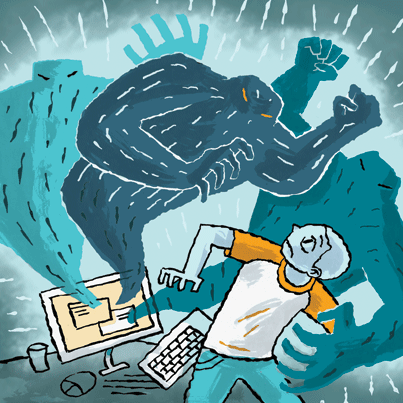Ruining Reputations with a Click of a Mouse
Ruining Reputations with a Click of a Mouse McGill University
User Tools (skip):
Ruining Reputations with a Click of a Mouse

Matthew Forsythe
Fear, depression, suicide: When cyberbullying creeps into today's schools, there's a lot more at stake than just lunch money.
BY DONNA NEBENZAHL, BA'75
Eight years ago, while Shaheen Shariff and her family were still living in B.C., her 15-year-old daughter received a terrifying email from an unknown source identifying himself only as "Raveger." "You don't know who I am," read the message, "but I know who you are. I've been watching you at school… And if you don't want to die…I'd sleep with one eye open."
Raveger turned out to be a classmate of Shariff's daughter. He was angry that she had refused to date him. After persistent questioning by school authorities, he admitted to sending the email.
It was an unsettling ordeal for the whole family, says Shariff, now a McGill-based authority on the issues surrounding cyberbullying. She found it particularly frustrating that the boy's web provider refused to cut off his email privileges once Shariff's family alerted the company to what was going on.
"That got me thinking about the legal issues, not as a parent who was upset, but looking in a more scholarly way," Shariff says. "Where are the boundaries between cyber and physical space? That's been my direction ever since."
As it turns out, those boundaries are often hazy and indistinct. A decade ago, cyberbullying was a fringe phenomenon that few educators or legal experts paid much attention to. Now, with governments and school authorities under increasing pressure to come up with policies for dealing with cyberbullying, it has become a growing concern.

Cyberbullying expert Shaheen Shariff is working toward new policies - and creative preventions - to address this high-tech scourge.
Claudio Calligaris
Shariff has emerged as one of the country's top experts on cyberbullying. An associate professor in McGill's Department of Integrated Studies in Education, she is frequently interviewed by the media on the topic and has advised school boards and governments on how to deal with it.
"It's virgin territory," says Professor Steven Jordan, PhD'96, the chair of Shariff's department. "Shaheen is at the forefront in terms of defining the particular problems that schools and school boards and departments of education have to deal with."
Jordan says Shariff understands the legal questions surrounding cyberbullying and has a solid grasp of how it all relates to the realm of education. The law has always been a passion for Shariff, who studied criminology at Simon Fraser University, then worked for 20 years as a legal assistant at Vancouver law firms.
"I always wanted to go to law school," she says. When she applied to study law at the University of British Columbia and was accepted at age 40, Shariff came to a difficult conclusion. She realized her children were still too young for her to commit to the grind of law school.
A partner at the law firm where she worked suggested that Shariff consider graduate studies at Simon Fraser's Centre for Education, Law and Society instead. A few years later, while working on her PhD, Shariff's daughter was targeted by "Raveger." Bullying then became the focus of her doctoral studies.
Shariff was in the throes of her dissertation on bullying and the law when she visited McGill with her daughter, who was starting university. She liked what she saw of McGill and noticed that the Faculty of Education was in the market for some new professors. Five years later, she is a tenured McGill professor and the lead investigator on two research projects focused on cyberbullying and funded by the Social Sciences and Humanities Research Council of Canada. This summer, Shariff and her research team collaborated with Netsafe in New Zealand in organizing that group's fifth international forum for discussing issues related to cybersafety. Shariff gave a keynote address.
A DIFFERENT TYPE OF BULLYING
In terms of its potential impact on victims, bullying —the old-fashioned, face-to-face kind—is now eclipsed by the online variety. While all forms of bullying do damage, cyberbullying's unique characteristics put it in a class all its own, Shariff says. "It's anonymous, it's permanent, perpetrators can invite an Internet audience, not just those who are physically present. It can resurface because people save the information and pass it on.
"It's one thing to have your reputation tarnished within a school. It would be even scarier to find yourself attacked online with the whole world able to witness it." The impact on victims can be devastating. Many suffer from profound depression. Some drop out of school.
For some Canadian teens—more than a half-dozen since 2000—the suffering experienced as a result of cyberbullying has been too much to bear. One of them was 14-year-old Hamed Nastoh of Surrey, B.C., who leapt to his death eight years ago after incessant bullying by classmates. In the opening pages of her new book, Cyber-bullying: Issues and Solutions for the School, the Classroom and the Home, Shariff wrote a dedication to the boy and printed his poignant suicide note.
Shariff says her daughter's experience is hardly uncommon. Research done by Shariff and other educators indicates that between 35 and 50 per cent of young people have been, or know someone who has been, cyberbullied through email, instant messaging or social networking sites like MySpace and Facebook.
Students aren't the only victims. A whopping 84 per cent of teachers claim to have been victims of cyberbullying. For their part, Canada's teachers are fed up with being targeted online. The abuse ranges from snide posts about their wardrobe to anonymous accusations of criminal misconduct. The Canadian Teachers Federation, which represents 220,000 teachers across the country, voted unanimously in July to pressure the federal government into making cyberbullying a criminal offence. The CTU argues that cyberbullying has become an occupational health and safety issue.
If there is to be legislation, Shariff believes it should exist only for very extreme cases, where the identity of the perpetrator is perfectly clear. Still, Shariff thinks the teachers' position is a little too self-serving. "Why didn't they do anything to address it when it was happening among the kids?"
Shariff doesn't think school administrators have exactly covered themselves in glory in their handling of these issues either. Too often, they have been more concerned about the potential damage that cyberbullying incidents might have on their schools' reputations than about the impact of the cyberbullying on its victims, says Shariff.
SHOULD SCHOOLS RESPOND?

“It’s anonymous, it’s permanent, you can invite an Internet audience, not just those who are physically present. It can resurface because people save the information and pass it on.”
Istockphoto.com
"One of the questions I get asked the most is, what are the responsibilities of schools in these cases?" It's tricky terrain. If a student targets a classmate for abuse outside of school hours and outside of school property, does the school still have an obligation to intercede? Shariff believes the answer is yes.
At a recent Faculty of Education launch for Shariff's new book, she pointed to a Supreme Court of Canada ruling from 1998 to support her point of view. In that case, the court indicated that schools "must provide an atmosphere that encourages learning" and that "during the school day, they must protect and teach our children." Shariff suggests that in an era where classmates are interacting 24/7 via text messaging and online chat groups, the definition of what exactly constitutes a "school day" isn't as clear-cut as it used to be.
Alan Lombard, director of the Quebec Provincial Association of Teachers (QPAT), says modern teacher training must include an understanding of cyberbullying. "A lot of what affects the school takes place elsewhere," he says. Cyberbullying poses a novel challenge to schools. "It's new and needs a lot of study and work. Very few people are doing that and making recommendations, which is what Dr. Shariff is doing."
If Shariff is critical of schools that try to sweep cases of cyberbullying under the carpet, she doesn't think much of "zero tolerance" approaches either. That's the message that Shariff delivered to educators this summer, when she was the featured speaker at a QPAT conference.
"I have been working on bullying for many years, and we're already seeing popular anti-bullying programs haven't been effective," she told the assembly. "Zero tolerance has minimal effects, resulting in more time and cost because of legal challenges and student protest."
In some cases, attempts by authorities to impose their control have been downright comical. Shariff points to an $89-million filtering system set up in Australia to carefully monitor web use. "It was hacked by a student in a half-hour."
Educators need to be more creative, Shariff argues, and move away from this focus on punishment. "I'm not against discipline, but zero tolerance has a boot-camp mentality. [Schools] think it's a deterrent and it's not." Zero tolerance withholds the opportunity for a dialogue, which is the only way students will understand the effect of their behaviour on the people they have picked on, she says.
Rather than being suspended or expelled, students need to be made aware of the impact their behaviours have had on the lives of others, says Shariff. That means standing in front of teachers, their families and other students. In the case of peer-to-peer bullying, it means facing the victim's parents, their siblings and friends. "We need more face to face, more understanding of what the other person is going through," she says. "We've got to give young people responsibility, put our trust in their ability to make the right choices. That's how you develop empathy."
What happens in the schools, she believes, is symptomatic of society. "These issues of discrimination, hostility and violence and lack of understanding others already exist outside the school." Instances of cyberbullying often reflect a poisoned atmosphere that was already present in a school, Shariff says.
Young people who bully lack empathy for others, but their behaviours are patterned on how we treat each other. "Generally in society there's a lack of caring about other people's needs; no one is accountable, no one is held responsible," Shariff says. "This is where children are growing up, in a superficial society with very little dialogue."

Istockphoto.com
REACHING OUT TO STUDENTS
Shariff argues that to the young, cyberspace looks like their own private, unsupervised world, where they can say whatever they want without adults butting in. That was true for five Ontario high school students, who were suspended for setting up a Facebook site to vent about their school's vice-principal. A rally in support of the students swelled in size and turned violent, as the students argued that because they were only exchanging views among themselves, they were being punished over what they called "private online comments," thus violating their freedom of speech.
Another Ontario student, Bram Koch, was suspended and missed a class trip to Montreal when he jokingly wrote on a friend's Facebook site that he had seen one of his teachers masturbating at the back of the class. Like the students in Ontario, he didn't see his behaviour as cyberbullying and felt the school had no right to intervene.
Such incidents can provide opportunities for learning, insists Shariff. She credits a high school in Winnipeg for showing imagination in the days leading up to Prime Minister Stephen Harper's recent official apology to former students of native residential schools. "The school asked its students to write the speech that the prime minister should give. That got them thinking about the residential schools and about who was affected and how they were affected."
That kind of approach can be applied to the issues that surround cyberbullying. "If I were the teacher about whom Bram wrote on Facebook, I would have students research the etymology of bullying, the history of bullying and school censorship controversies involving freedom of expression and supervision—and ask them to come to decisions about where the lines crossed over to become cyber-libel and criminal expression. Moreover, I would attempt to find out what fuelled the anger that resulted in the comments made online."
Shariff doesn't believe that cyberbullying is a full-blown crisis. When teens see overheated news-paper headlines about cyberbullying, they worry— sometimes with good cause—about parental overreactions. Technology, in and of itself, is not the enemy.
Earlier this year, Shariff served as a member of a task force led by former Concordia University president Claude Lajeunesse that examined the impact of the Internet and related technologies for the Quebec English School Boards Association. The Internet, she argues, can be used to solve problems as well as create them. Most students use these technologies responsibly—even creatively—to support their learning and socializing. "There needs to be more focus on the positive aspects."
It isn't enough to just hand down edicts from on high about how students should behave, Shariff suggests. Invite them to be part of the process when you create the rules in the first place. "Give them a voice," says Shariff. In some ways, students are the experts when it comes to these issues. "They know how their peers are using these technologies."
In one of its key recommendations, the Lajeunesee-led task force suggested that students should be invited "to contribute to the development of codes of conduct and policies to address online abuse."
"The strongest card we have," says Shariff, "is getting kids involved."
Donna Nebenzahl is a freelance magazine and newspaper writer, and a columnist at the Montreal Gazette. She teaches journalism at Concordia University and is the author of Womankind: Faces of Change Around the World.


